The IRS has released the 2025 inflation adjustment figures for over 60 tax provisions in Revenue Procedure 2024-40. Many tax amounts will see increases in 2025, though not as substantial as in 2024. It’s important to recognize that many of these adjustments could change significantly in 2026, as provisions under the Tax Cuts and Jobs Act (TCJA) are set to expire. There may also be new tax legislation that could impact your tax and financial position sooner than expected.
Individual Income Tax Rates
The thresholds for tax brackets will increase for all filing statuses, but the effect will be more pronounced in the higher brackets due to the progressive nature of the tax rates.
| 2025 ordinary-income tax brackets | ||||
| Tax rate | Single | Head of household | Married filing jointly or surviving spouse | Married filing separately |
| 10% | $0 – $11,925 | $0 – $17,000 | $0 – $23,850 | $0 – $11,925 |
| 12% | $11,926 – $48,475 | $17,001 – $64,850 | $23,851 – $96,950 | $11,926 – $48,475 |
| 22% | $48,476 – $103,350 | $64,851 – $103,350 | $96,951 – $206,700 | $48,476 – $103,350 |
| 24% | $103,351 – $197,300 | $103,351 – $197,300 | $206,701 – $394,600 | $103,351 – $197,300 |
| 32% | $197,301 – $250,525 | $197,301 – $250,500 | $394,601 – $501,050 | $197,301 – $250,525 |
| 35% | $250,526 – $626,350 | $250,501 – $626,350 | $501,051 – $751,600 | $250,526 – $375,800 |
| 37% | Over $626,350 | Over $626,350 | Over $751,600 | Over $375,800 |
Note: Under the Tax Cuts and Jobs Act (TCJA), these rates and brackets are set to revert to pre-TCJA levels (inflation-adjusted) in 2026 unless Congress enacts an extension or makes additional changes.
Standard Deduction
The TCJA nearly doubled the standard deduction and indexed it for inflation through 2025. In 2025, the standard deduction will be:
- $30,000 for married couples filing jointly
- $22,500 for heads of households
- $15,000 for singles and married individuals filing separately
After 2025, the standard deduction is scheduled to return to pre-TCJA amounts. Additionally, the personal exemption that was suspended by the TCJA is set to be reinstated in 2026, unless Congress extends the suspension.
Long-Term Capital Gains Rates
Long-term capital gains apply to investments held for more than a year. The tax rates for long-term gains are 0%, 15%, or 20%, depending on your taxable income.
| 2025 long-term capital gains brackets | ||||
| Tax rate | Single | Head of household | Married filing jointly or surviving spouse | Married filing separately |
| 0% | $0 – $48,350 | $0 – $64,750 | $0 – $96,700 | $0 – $48,350 |
| 15% | $48,351 – $533,400 | $64,751 – $566,700 | $96,701 – $600,050 | $48,351 – $300,000 |
| 20% | Over $533,400 | Over $566,700 | Over $600,050 | Over $300,000 |
Note: Higher rates apply to certain asset types. As with ordinary income rates, long-term capital gains rates are set to revert to pre-TCJA levels in 2026 unless Congress intervenes.
Alternative Minimum Tax (AMT)
The AMT operates as a separate tax system that limits certain deductions and treats some income items differently. If your AMT liability exceeds your regular tax liability, you must pay the AMT.
Like the regular income tax brackets, the AMT thresholds are indexed for inflation each year. In 2025, the threshold for the 28% AMT bracket will increase by $6,500 for all filing statuses except married filing separately, which will see an increase of $3,250.
| 2025 AMT brackets | ||||
| Tax rate | Single | Head of household | Married filing jointly or surviving spouse | Married filing separately |
| 26% | $0 – $239,100 | $0 – $239,100 | $0 – $239,100 | $0 – $119,550 |
| 28% | Over $239,100 | Over $239,100 | Over $239,100 | Over $119,550 |
The AMT exemptions and phaseout ranges are also adjusted for inflation. In 2025, the exemption amounts will be:
- $88,100 for singles
- $137,000 for joint filers
The phaseout ranges will be:
- $626,350–$978,750 for singles
- $1,252,700–$1,800,700 for joint filers
Phaseout ranges for married couples filing separately are half those for joint filers. These amounts were significantly increased by the TCJA, but unless Congress acts, they will return to pre-TCJA levels in 2026.
Education and Child-Related Tax Benefits
Many education and child-related tax credits will remain the same in 2025, but their benefits are subject to income limits based on Modified Adjusted Gross Income (MAGI). Taxpayers whose MAGI falls within the phaseout range can qualify for partial benefits, while those whose MAGI exceeds the top of the range are ineligible.
Some key adjustments for 2025:
- The American Opportunity credit. For tax years beginning after December 31, 2020, the MAGI amount used by joint filers to determine the reduction in the American Opportunity credit isn’t adjusted for inflation. The credit is phased out for taxpayers with MAGIs in excess of $80,000 ($160,000 for joint returns). The maximum credit per eligible student is $2,500.
- The Lifetime Learning credit. For tax years beginning after December 31, 2020, the MAGI amount used by joint filers to determine the reduction in the Lifetime Learning credit isn’t adjusted for inflation. The credit is phased out for taxpayers with MAGIs in excess of $80,000 ($160,000 for joint returns). The maximum credit is $2,000 per tax return.
- The adoption credit. The MAGI phaseout range for eligible taxpayers adopting a child will increase in 2025 — by $7,040. It will be $259,190–$299,190 for joint, head-of-household and single filers. The maximum credit will increase by $470, to $17,280 in 2025.
Note: Married individuals filing separately are generally not eligible for these credits.
These credits are just a few examples of the education and child-related breaks that may apply to you. If your MAGI exceeds the limits, your child may still qualify to claim these credits on their own tax return.
Gift and Estate Taxes
Both the unified gift and estate tax exemption and the generation-skipping transfer (GST) tax exemption are adjusted annually for inflation. In 2025, the exemption amount will rise to $13.99 million, up from $13.61 million in 2024. The TCJA nearly doubled these exemptions beginning in 2018. Unless extended by Congress, these exemptions are set to reduce significantly in 2026.
The annual gift tax exclusion will increase by $1,000 to $19,000 in 2025, unaffected by the TCJA’s scheduled expiration.




